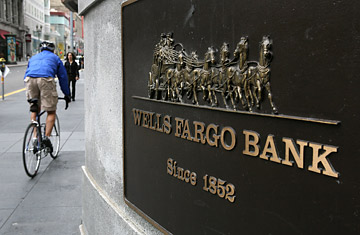
A bicyclist rides by a Wells Fargo branch in San Francisco
Federal Reserve chairman Ben Bernanke, speaking via satellite to a bank conference sponsored by the Chicago Federal Reserve Bank, said on Thursday morning that the stress tests "will allow, I hope, for greater confidence in the banks." But even though the stress tests are over, the banks and their investors are not out of the woods.
The biggest issue left unresolved by the stress tests, which concluded that 10 of the 19 top U.S. banks need an additional $75 billion in capital, is how the banks will get de-stressed. Originally, when Treasury Secretary Timothy Geithner announced the tests, he said they would determine how much additional capital banks needed to remain solvent, and the government would then provide that amount to the banks. Now the Treasury is giving the banks that are believed to need additional money, including Bank of America, Citigroup and Wells Fargo, until June 8 to come up with their own plan to fix their financial problems. (See pictures of the dangers of printing money.)
That means the banks face another test just one month from now. It's similar to the strategy the government took with the automakers, which were also asked to present a recovery plan before receiving new government funds. So, just like the automakers, expect some big changes at the banks over the next month. Top executives of Bank of America, Citigroup or Wells Fargo could be out of a job. The government may also decide it wants a much bigger stake in the banks than some are currently letting on. Maybe Tim Geithner and Ben Bernanke are better at tying up loose ends than Steve Rattner and the Automotive Task Force, but odds are there more chapters to come in the big bank crisis.
Of course, the government is hoping that the stress tests will be the beginning of the end of the bank crisis because they will raise confidence in these institutions and even give bank stocks a boost. As news of the results has trickled out in recent days, bank stocks have indeed shot higher as investor fear has subsided. But longer term a big issue remains: Investors need to know just what the government's stakes in these banks are worth since that directly affects what the investors' stake is worth. The government says the future stakes it takes in the banks will not be common equity, but preferred stock that is convertible into common equity — though it may or may not be converted. (Read about the top 10 bankruptcies.)
That raises a question for investors. If the government buys the bank's common stock outright, investors know how much their own stake is diluted. But since some of the preferreds may convert and others won't, investors are left with a less clear picture of a bank stock's worth.
In the end, the stress tests may do most for depositors, letting them know that their financial institutions are either in good shape or being repaired. That may allow the government to start rolling back some of extra safety nets it has set up over the past year. So even though the stress tests may not be a boon for investors, they are still a positive development.
